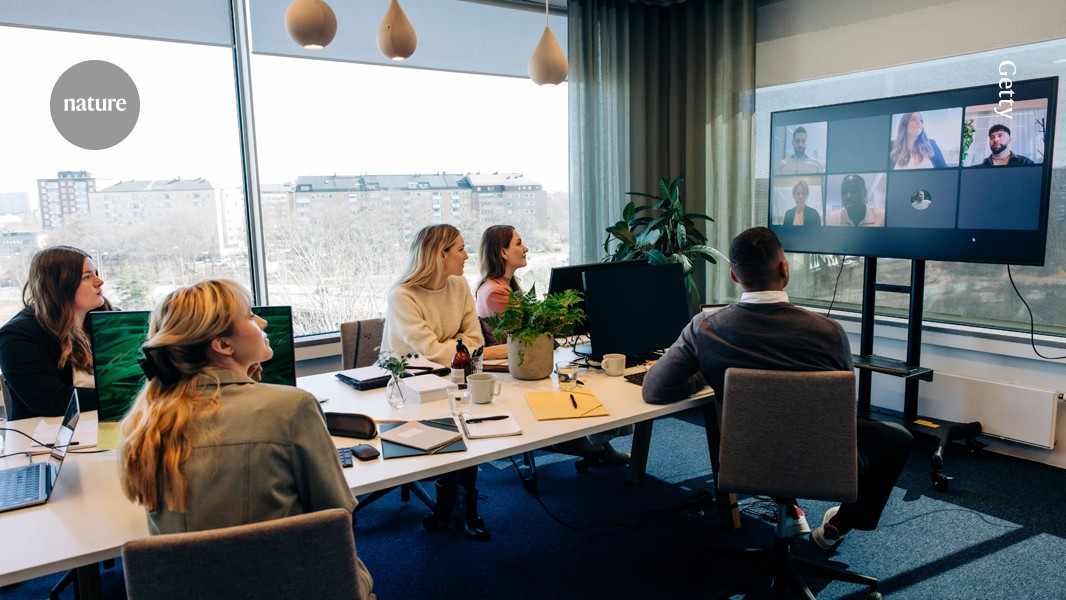Hybrid conferences should be the norm — optimize them so everyone benefits

The option to attend meetings remotely provides career benefits to parents, carers, people with disabilities and others facing barriers to travel

Organizers of hybrid events need to incorporate opportunities for virtual networking and collaboration.Credit: Getty
Attending conferences is a crucial way to establish and build networks, especially for scholars early on in their careers. But not everyone who would benefit is equally able to attend. Many researchers have caring responsibilities. The impact is particularly pronounced for women with children, who often find it hard to juggle professional and personal commitments — thanks, in no small part, to persistent societal expectations that they will be a family’s principal carer. In a 2019 study of oncologists, Miriam Knoll, a radiation oncologist at Northwell Health who is based in New York City, and her colleagues found that women attended fewer conferences than did men, and were more likely to cite childcare responsibilities as the reason (M. A. Knoll et al. JAMA Oncol. 5, 1503–1504; 2019).
What’s needed is a cultural shift, says Laura Pallett, an immunologist at University College London and one of the authors of a Careers Column published in Nature in May on the difficulties parents face with conference travel (L. Carter et al. Nature 630, 517–518; 2024). That shift must include two things. First, more targeted support from institutions and funders for those with caring responsibilities who might otherwise not be able to attend conferences. Second, greater effort from conference organizers to make provision for a high-quality hybrid experience.
On the first of these, some progress has already been made — but it needs to be built on and normalized, all of which requires resources. In the United Kingdom, funders such as UK Research and Innovation and the country’s science academy, the Royal Society, offer reimbursements covering childcare, family travel and other care costs incurred outside normal working patterns.
For a limited period this year, the African Academy of Sciences (AAS), based in Nairobi, offered funding for researchers who were breastfeeding to pay for someone to travel with them and help care for a child at conferences, says AAS executive director Peggy Oti-Boateng. Such support should be available for other events, and all funders should “enhance gender-transformative actions”, she adds.
Some universities do help to cover childcare costs for staff attending conferences. One is the University of Michigan in Ann Arbor, which does so through its Elizabeth Caroline Crosby Research Awards. Conference organizers can also play a part, by offering funding and childcare facilities, or at least a list of vetted childcare providers in the local area. “These kinds of programmes have an impact beyond the individuals they help,” says Reshma Jagsi, an oncologist and member of the US National Academies of Sciences, Engineering, and Medicine’s Committee on Women in Science, Engineering, and Medicine. “It’s not just the early-career faculty member who brings their child along to the meeting, but the myriad students who are trying to decide whether they can be happy and successful in a discipline.”
The alternative way to make conferences genuinely accessible is to offer more of them virtually, a practice that became widespread during the COVID-19 pandemic. This also has environmental benefits (M. Klöwer et al. Nature 583, 356–359; 2020). Nevertheless, some organizers are beginning to step away from virtual meetings.
One reason is that it is difficult to organize hybrid events in a way that satisfies both in-person and online delegates, and doing so pushes up costs. A big draw of in-person conferences is the networking and collaboration opportunities, which are hard to replicate in an online or hybrid format. This needs to be addressed to ensure that virtual attendees do not suffer.
Another reason is that conference presenters are often reluctant to discuss unpublished research or work in progress in front of a virtual audience. Such work is the lifeblood of conferences, and in-person delegates are able to access and discuss it on the understanding that they respect any requests for data or results to be kept confidential.
But such problems exist to be overcome. We would encourage conference organizers to redouble their efforts to find technological fixes and to share best practices — and for attendees to highlight solutions that have worked for them. Organizing committees should prioritize making their events available online, not only for parents with childcare commitments, but also for people who lack the funds or visas, or are otherwise unable to attend in person.
It will not always be possible to offer real-time hybrid events, especially for events held in locations with slow Internet connections or those that are volunteer-led and lack external funding. At a minimum, sessions should be recorded and made available to watch; funders could make this a condition for access to conference grants.
There are many potential solutions to the problem of conference accessibility, but their success is context-specific. Interventions should be rigorously monitored to see what works best. “This hasn’t been done before, so a learning agenda is critical,” says Amie Batson, president of WomenLift Health, a non-profit body based in Seattle, Washington, that promotes gender equity in leadership. “If there are several options on the table, I expect that in five years you’ll learn that three are super-valuable, two were worthless and two new ideas came up. What’s important is making sure that you’re creating the space to learn and respond to what works for women, families and organizations.”
To improve things, the first step is acknowledging some of the problems, according to researchers and institutions that Nature spoke to for this Editorial. Conference organizers and funders need to confront the reality that the childcare status quo disadvantages many researchers and harms science as a whole — and then start to change it.
Nature 632, 229 (2024)
doi: https://doi.org/10.1038/d41586-024-02533-z
This story originally appeared on: Nature - Author:furtherReadingSection


















